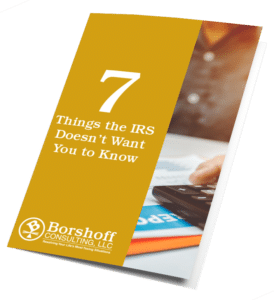The Additional Child Tax Credit (ACTC) is a tax credit for taxpayers who get less than the full amount of the Child Tax Credit. This credit may give you a tax refund even if you don’t owe any tax when you file your annual tax return.
That’s why some tax credits, as opposed to tax deductions, are so beneficial. The refundable tax credits typically offer taxpayers the opportunity to receive a tax refund if their credit amount is greater than the amount of their tax liability.
There are specific rules as to whether or not you can even take this credit. You must have also taken the Child Tax Credit; if you only were able to take the Credit for Other Dependents and not the Child Tax Credit, you do not qualify to take the Additional Child Tax Credit.
It is advisable that if you plan to take tax credits, you should enlist the help of a qualified tax consultant. This is recommended because tax professionals know the ins and outs of which forms and which schedules to use. Also, a tax accountant should know the latest rules, regulations, and laws as they relate to the subject of taxes.
In this article, we will take a close look at what this tax credit is all about, including the requirements you must meet to take the ACTC, the current year’s amount for this tax credit, and how to fill out the IRS forms and schedules as they pertain to this tax credit.
What is the Additional Child Tax Credit?
The Additional Child Tax Credit (ACTC) is a refundable tax credit for those who do not get the full amount of the Child Tax Credit. This tax credit may provide you with a tax refund even if you do not owe any tax, provided it’s a refundable tax credit. However, even the nonrefundable tax credits provide you with a tax break because they reduce the amount of your tax liability.
Who is allowed to claim the tax credit?
The Additional Child Tax Credit (ACTC) was created for certain taxpayers who get less than the full amount of the Child Tax Credit. You must be a United States citizen or resident alien who has submitted or will submit a federal tax return.
Unfortunately, the Credit for Other Dependents (ODC) cannot be used when calculating the amount of the Additional Child Tax Credit; only the Child Tax Credit applies to this tax credit. If you claim the ODC but do not claim the Child Tax Credit, you are not eligible to claim this credit.
Also, if you file IRS Form 2555: Foreign Earned Income (or IRS Form 2555-EZ), as related to foreign earned income, you are not eligible to claim the Additional Child Tax Credit.
How much is this tax credit worth?
The Additional Child Tax Credit is worth up to 15% of your taxable income over $2,500. The maximum amount that you can reduce your tax bill and possibly receive a refund on is $2,500. That is the refundable portion of the Child Tax Credit.
How does the tax credit work when filing your taxes?
To claim the Additional Child Tax Credit, use the following steps.
Step One: Be sure you calculate the correct amount (if you had any) of your Child Tax Credit and Credit for Other Dependents using the appropriate Child Tax Credit and Credit for Other Dependents Worksheet.
Step Two: If you answered YES on line 11 or 12 of that worksheet in the IRS Form 1040 or IRS Form 1040-NR (or on line 16 of that worksheet), and line 1 of that worksheet is greater than zero, you need to use IRS Schedule 8812: Additional Child Tax Credit (ACTC) to see if you are eligible to take the ACTC.
Step Three: If you have an Additional Child Tax Credit amount on line 15 of IRS Schedule 8812, you need to carry it onto IRS Form 1040, line 17b (or IRS Form 1040-NR, line 64).
Step Four: You must identify each qualifying child under the age of 17 for whom you are claiming the Additional Child Tax Credit. Enter the Social Security number for each child in column 2 of the “Dependents” section of your annual tax return. You also need to check the box in column 4 called “Child Tax Credit.”
Step Five: You will not be eligible to claim the Additional Child Tax Credit if the amount on line 1 of your Child Tax Credit and Credit for Other Dependents Worksheet is zero. If this is the case, do not complete IRS Schedule 8812: Additional Child Tax Credit.
Please note that you may be able to use your prior year’s earned income to figure the amount of Additional Child Tax Credit you are eligible for, provided your main home (or that of your spouse) was located in one of the federally declared disaster areas eligible for this kind of relief. To determine if this applies to you, see IRS Schedule 8812: Additional Child Tax Credit.
If you are able to use your prior year’s earned income to claim the Earned Income Tax Credit, you have to use that amount to claim the Additional Child Tax Credit.
What else should I know about this tax credit?
There are certain rules that pertain to who the dependent for the Additional Child Tax Credit (ACTC) can be. The eligible child for the ACTC must be 16 years old or younger at the end of the tax year. He or she also must be a dependent on your federal tax return. The qualified dependent must not have provided more than half of his or her own financial support.
The child must be a United States citizen, national, or resident alien, as well. He or she must have lived with you for more than half of the tax year. He or she must be claimed as a dependent on
To be considered as a qualifying dependent, the same rules apply for dependents as are found for the Child Tax Credit. If a child qualifies for the purposes of the Child Tax Credit, he or she will qualify for the Additional Child Tax Credit.
For example, the relationship test may be met if the dependent is your child, stepchild, foster child, grandchild, niece, nephew, brother, sister, stepbrother, stepsister, halfbrother, halfsister, father, mother, grandparent, or other direct ancestors, as specified by the IRS.
There are even more ways that a person can qualify as a dependent and rules that are important to follow; those are just some of the ones listed on the IRS’s website in IRS Publication 501.
As for most other tax credits, such as the Child and Dependent Care Tax Credit, IRS Publication 503: Child and Dependent Care Expenses may help clarify which expenses are deemed applicable for this tax credit.
Conclusion
Are you struggling with the decision of which tax credits you are eligible to take? Have you taken the Child Tax Credit but are unsure as to whether you qualify for the Additional Child Tax Credit? Don’t worry; you aren’t alone. Many people have difficulty navigating the various forms and schedules that are required during tax season.
Make sure you have the right tax representative in your corner when you fill out your tax forms this year. You’ll want someone who can help you have the best tax results without stepping over the line. After all, the last thing anyone wants is an IRS tax audit!
Are you anticipating an IRS audit but don’t know how to prepare for it? We can help! Just contact us today to find out how our services can benefit you.
If we don’t have the answers, we’ll find someone who does! We are more than happy to guide you along and handle any tax or business concerns.
Did you know that at Borshoff Consulting, we can help you with your tax return? We also do tax representation during a tax audit and business consulting. Let us worry about which forms and schedules you need to have completed for your tax return to be maximized but also correct. You can trust Indiana’s tax expert to steer you in the right direction with your taxes this year!





